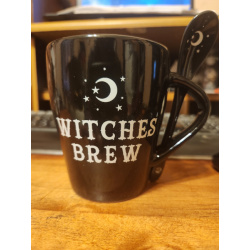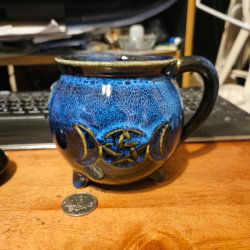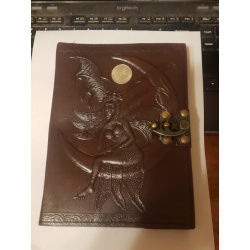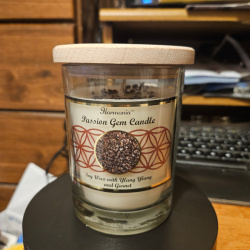Latest Products
-
 Witch's Brew Mug w/ Spoon
12.20€
Witch's Brew Mug w/ Spoon
12.20€ -
 Triple Moon Pentacle Mug
18.77€
Triple Moon Pentacle Mug
18.77€ -
 Moon Fairy Journal
42.23€
Moon Fairy Journal
42.23€ -
 Gem Soy Wax
14.08€
Gem Soy Wax
14.08€
Atropa Belladonna - Herb
1 OzCulpepper has this to say: It is of a cold nature; in some it causeth sleep; in others madness, and, shortly after, death. – Culpeper’s Complete Herbal
So what exactly is the deal with it?
According to WebMD, the way belladonna works is that it has chemicals that block nervous system functions. Belladonna was in the past used in small doses as a sedative, to ease bronchial spasms and as a cold and allergy remedy. It's found in remedies for ointments used for joint pain, sciatica and nerve pain. It's been used to control excessive sweating and been found in hemorrhoid suppositories. It's currently being explored in its potential for treating Parkinson’s, nerve problems and some other conditions.
Atropine is used as a poison treatment because it can block or reverse some of the more adverse effects of certain medicines and pesticides. It's ironic how nature works in letting us derive a poison antidote from a highly poisonous plant.It's also used in medicines to dilate the pupils. In fact, this particular use may be how the plant got its name belladonna, which means “beautiful woman” – young ladies of ancient Rome would use it to dilate the pupils to make their eyes alluring and bewitching
Magical:
The name “Atropa” is from “Atropos”, one of the Greek Fates. It is she who would cut the thread when it was time to end a man’s life.
Because of its toxic nature, belladonna has been used in many death potions, hexes and curses. It's closely associated with the underworld, and used to consecrate and charge tools used to commune with spirits, or in incenses to attract the dead (never burn belladonna indoors and never directly inhale-- in fact, it's best to skip it and use a safer alternative).Belladonna was also occasionally found in beauty spells and potions. There's a legend from the Middle Ages that says the plant was actually an enchanted being and on certain nights it would transform into a beautiful woman who would then lure men to their deaths.
The most well-known use by far, however, is its use as an ingredient in so-called ‘flying ointments’. Folklore tells us these ointments were used by Witches to fly on sticks (or more modernly, broomsticks); however, in reality it is suspected that these ointments were used by ancient shamans and Witches to induce a trance state and astral projection-- a whole different type of 'flying'.
Some say that it was applied vaginally by use of a broomstick handle-- though I question that claim. First because witches weren't even associated with brooms (look at all the paintings and sketches pre-18th century; they're on sticks, not brooms). Second, because it just sounds like an awkward way to apply a lotion.
A lot of these flying ointment recipes have survived until today, with other poisons such as datura and henbane. I recommend you do not use them as these plants can make you permanently mad (if they don't kill you first). There are much safer alternatives to promote astral projection.
In Christian folklore, the devil loved belladonna so much he would guard it most of the year. The only safe time to harvest or kill the plant without enduring his wrath was on May Eve, when he was called away for the 'witches sabbats'.
By some accounts, belladonna was sacred to Bellona, the Roman Goddess of war. This may be another possible root of the plant’s name. Priests of Bellona would drink a belladonna infusion before prayers and meditations-- which no doubt gave them a number of visions (mostly hallucinations, I’m guessing).
By other accounts, it was sacred to Circe, an enchantress or (in some depictions) a Goddess of magic, who was widely known for her expertise with potions and herbs. She was known for using her herbs to transform people who crossed her into animals. If you've read the Odyssey of Homer, the crew comes across Circe's island in their travels. She feeds them but it's laced with potions that turns them into swine.
- Availability: 16 In Stock





